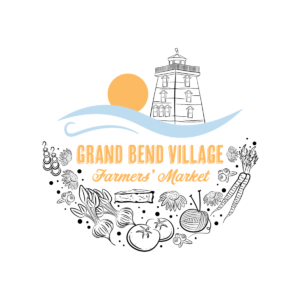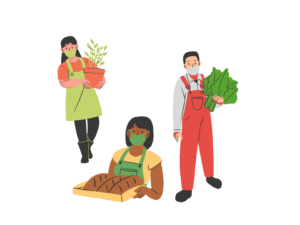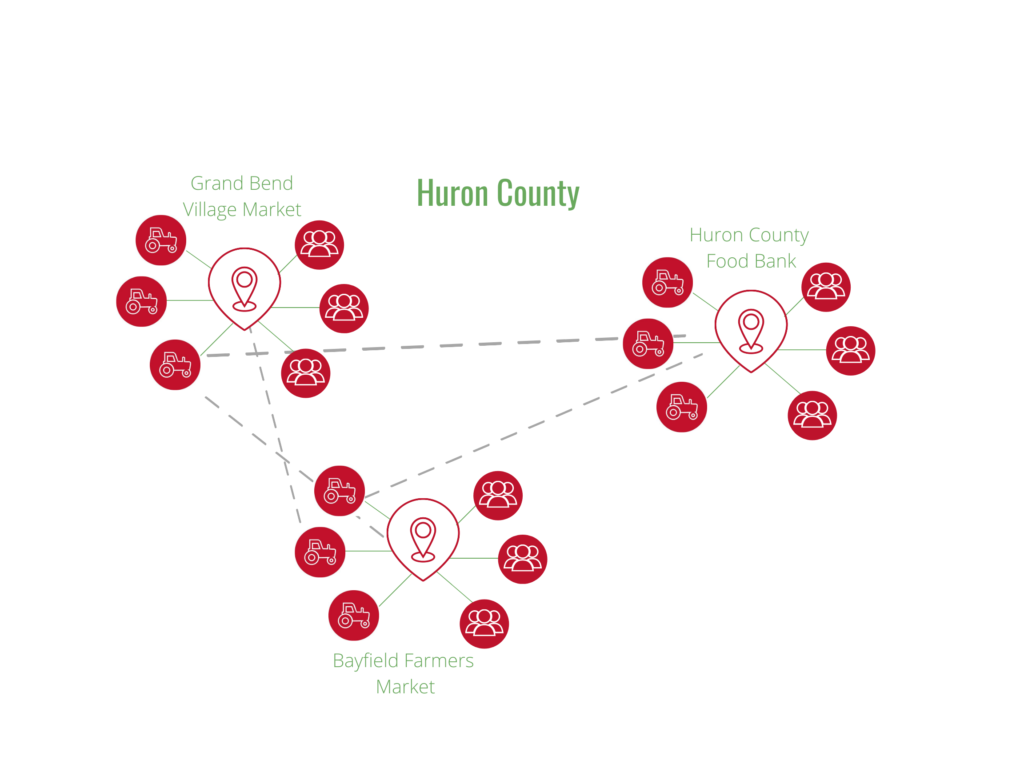Case Study
Huron County

Huron County Community Network
Located along the shores of Lake Huron in Southwestern Ontario, Huron County is one the most agriculturally productive areas in the province. Although the majority of the farming in the region is still export driven, stakeholders have been working to support and expand local food enterprises. Using the Open Food Network platform to coordinate, local economic development agency Community Futures Huron has begun actively building the local system, connecting farmers, food producers and consumers through hybrid online/in-person farmers’ markets.
Beyond connecting producers with consumers, stakeholders in Huron County have a broader and more ambitious vision for the local food system in the future. One goal is to increase food security for vulnerable people in the region by linking local growers and farmers’ markets into the food bank system. Unfortunately, the pandemic forced a pause in this progress, as food bank volunteers were inundated with immediate needs. However, as the county and world emerge from this crisis, stakeholders continue to explore ways to link farmers’ market suppliers with the food bank distribution system, as well as school food programs, creating more extensive and equitable access to local food.
A Hybrid Model for Growth
Huron County has seen significant growth in traditional, in-person farmers’ markets in the past decade. When stakeholders considered additional ways to support growers and food producers, it was agreed that developing a hybrid system of farmers’ markets would help expand reach and increase profitability.
With the support of Community Futures Huron and using the OFN platform, online marketplaces were established for the Grand Bend Village Farmers’ Market and Bayfield Farmers’ Market, and later the Blyth Community Market. Collectively, these markets represent dozens of local vendors, ranging from farmers to brewers to artisanal bakers.
Organizers and shoppers are committed to the local food movement. At the Bayfield Farmers’ Market, for example, any food that vendors sell must be produced within 75 kilometers of the town, with no resellers allowed.
Each of these markets operates with similar but individualized processes, and with overlapping but varied vendors. The basic model is simple: For several days each week, shoppers can visit the online markets to select fresh produce and prepared food, with the local sources always identified. Pick-ups are available on an appointed day or customers can pay a small fee for local delivery. Each of the markets also host a traditional in-person farmer’s market for those who prefer to browse, with many but not all vendors participating in both the online and in person versions.
Stronger Together
By networking together into an online farmers’ market, growers and food producers save time, money and effort. OFN provides affordable e-commerce solutions, and with the ability to manage products and inventory in one online list, vendors can more easily and efficiently participate in multiple farmers’ markets and other hubs. A big benefit of this system is the crossover marketing that results: farmers’ markets promote their vendors, while their vendors’ independent profiles also spread awareness of the various markets they participate in.
This emphasis on interconnected local food distribution helped to preserve rural livelihoods during the Covid-19 crisis and beyond, supporting new and small-scale suppliers, stimulating the local economy, and creating additional jobs within the community.
The Future of Food Security
Beyond connecting producers with consumers, stakeholders in Huron County have a broader and more ambitious vision for the local food system in the future. One goal is to increase food security for vulnerable people in the region by linking local growers and farmers’ markets into the food bank system. Unfortunately, the pandemic forced a pause in this progress, as food bank volunteers were inundated with immediate needs. However, as the county and world emerge from this crisis, stakeholders continue to explore ways to link farmers’ market suppliers with the food bank distribution system, as well as school food programs, creating more extensive and equitable access to local food.
We're Here to Help
Have an idea, a project or a question? Want help using the Open Food Network software? Get in touch and find out how we can help you with it.

Open Food Network is a free and open source software platform. Our content is licensed with CC BY-SA 3.0 and our code with AGPL 3.
We take good care of your data. See our cookies policy





